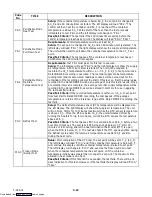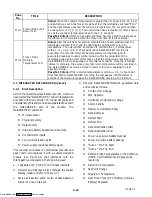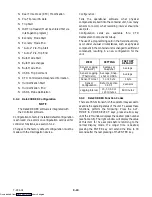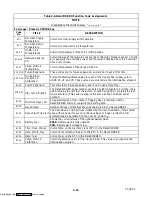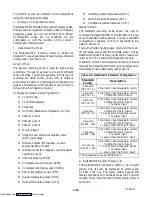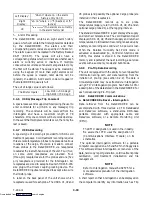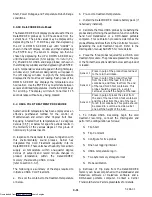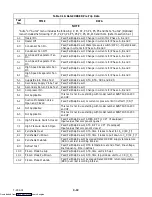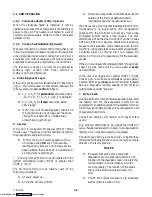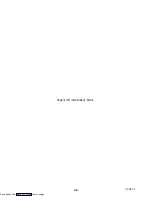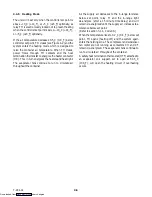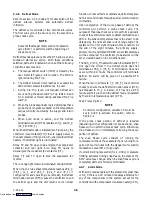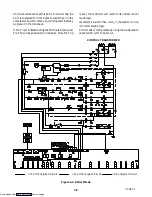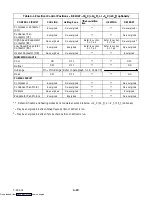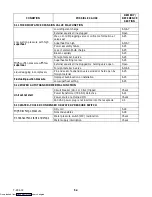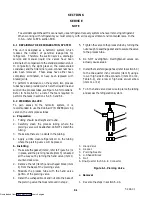
4-2
T-294-01
4.4 UNIT OPERATION
4.4.1
Crankcase Heater (CCH)-- Optional
When the crankcase heater is installed, it will be
operational whenever the compressor is off and there is
power to the unit. The heater is connected to a set of
normally closed auxiliary contacts on the compressor
contactor (CH).
4.4.2
Probe Check Initiation (Optional)
Whenever the unit is in normal control mode, that is, not
in pre-trip, defrost or shutdown modes and there are NO
active probe alarms, and alarm codes AL11 and AL12
are inactive (for units so equipped), the following probe
diagnostic functions are performed by the controller.
The following is based on current ML2i operational
software logic, version 5103. Older versions of
software will have differences.
a. Probe Diagnostic Logic
If the unit is configured for standard (Std) “Probe Check
Logic,” the criteria used for comparison between the
primary and secondary
control
probes is:
S
1
_
C (1.8
_
F) for
perishable
set points, above
--10
_
C (+14
_
F), or --5
_
C (+23
_
F) optionally.
S
2
_
C (3.6
_
F) for
frozen
set points, below
above range.
S
If 25 or more of 30 readings taken within a 30
minute period are out-of-range per the above
criteria, then a defrost* is initiated and a
probe check is performed.
b. Special
If the unit is configured for special (SPEC) “Probe
Check Logic,” the above criteria is identical except for
the diagnostic readings which are:
S
If 25 or more of 30 readings taken within a
30 minute period
OR
any 10 consecutive
readings at any time are out-of-range per the
above criteria, then a defrost* is initiated and
a probe check is performed.
* The only time defrost will not be initiated is if the
defrost termination sensor (DTS) is greater than
25.56
_
C (78
_
F).
The 30 minute timer will be reset for each of the
following conditions:
S
At every power up.
S
At the end of every defrost.
S
After every diagnostic check that does not fall
outside of the limits as described under
“standard or special” as outlined above.
If AL55 is active, meaning that the DataCORDER (DC)
functionality is no longer active (DC configuration
variable off), the Controller will act as a four probe
configured system during probe checks. The only
differences will be that the Controller Function Codes
Cd38 and Cd39 will become enabled thus allowing
access to the secondary probe readings since the DC
functions, codes and alarms have become deactivated.
Controller alarms AL70 and AL71 will replace DC
alarms AL70 and AL71 respectively for the secondary
probes.
If the unit is configured for standard (Std) “Probe Check
Logic,” a probe check will be run as a part of
every
normal defrost.
If the unit is configured for special (SPEC) “Probe
Check Logic,” a probe check will
not
be run as a part of
a normal defrost, but
only
as a part of a defrost initiated
due to a diagnostic reading outside of the limits as
outlined above under “special.”
c. Probe Check
During a defrost cycle that includes a probe check, after
the heaters turn off, the evaporator motors will be
energized for an additional eight minutes after which all
the primary/secondary probes will be compared to a set
of predetermined limits.
The defrost indicator will remain on throughout this
period.
Any probe(s) determined to be outside the limits will
cause the appropriate alarm code(s) to be displayed to
identify which probe(s) needs to be replaced.
The limits used during a probe check are tighter than
those used for the diagnostic criteria to ensure accurate
detection of a faulty probe(s).
NOTES
S
Be aware that probe check and probe
diagnostics are two separate functions. The
function of the diagnostic logic is to alert the
microprocessor of a discrepancy with the
control probe(s). The function of the probe
check is to determine what probe(s) is in
error.
S
The P5 Pre-Trip test must be run to inactivate
alarms (refer to section 3.2.1).
Downloaded from

